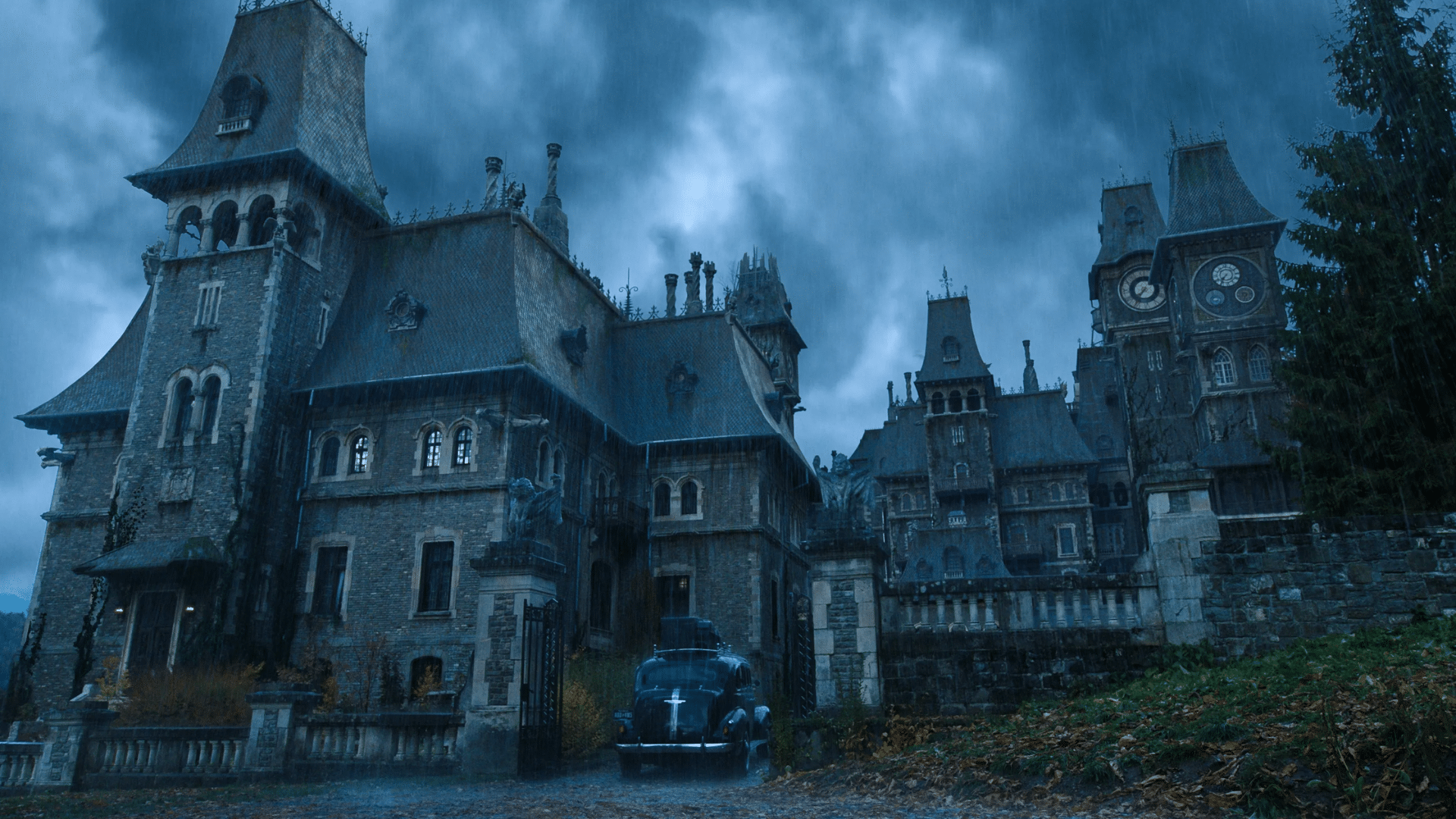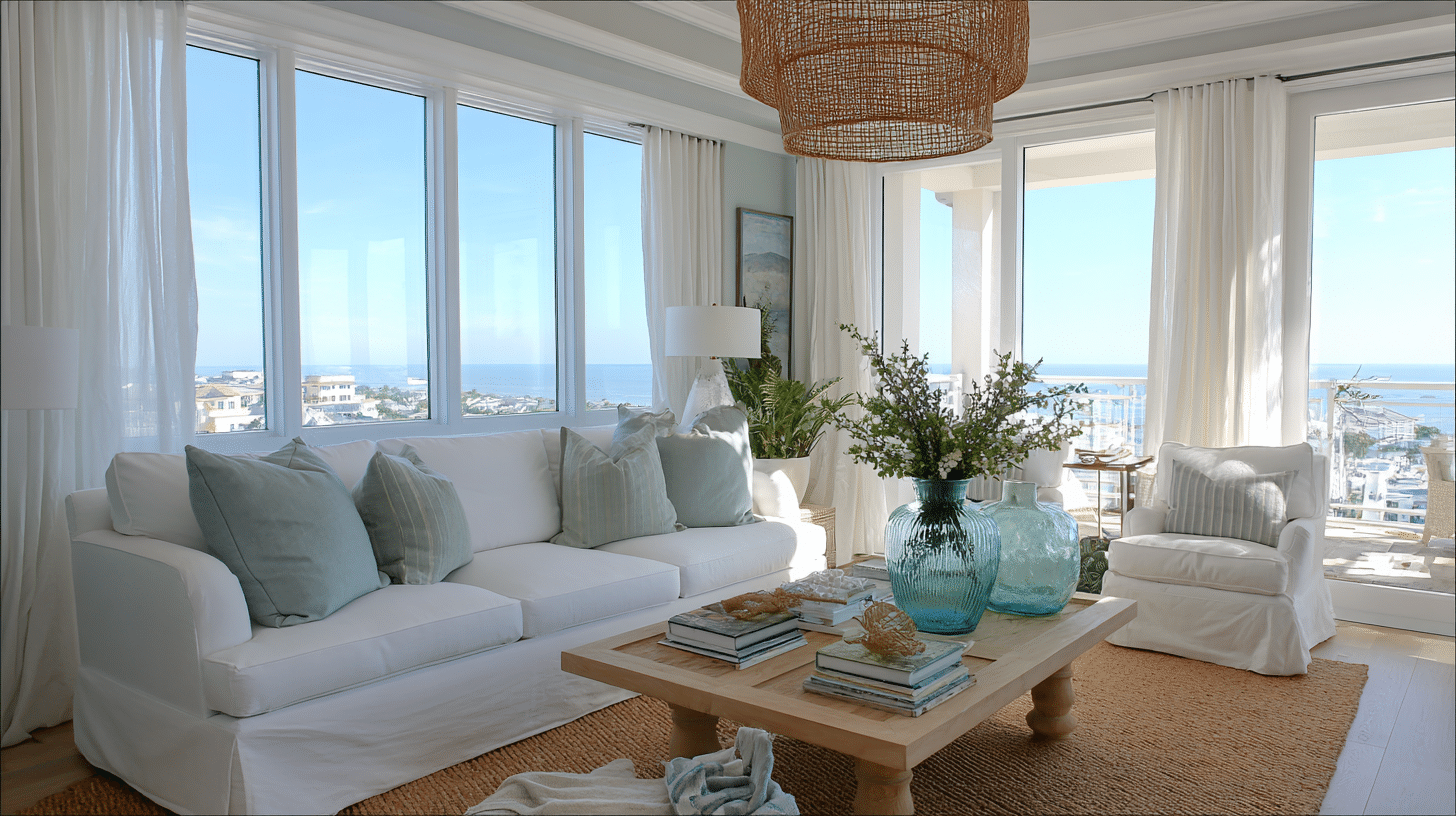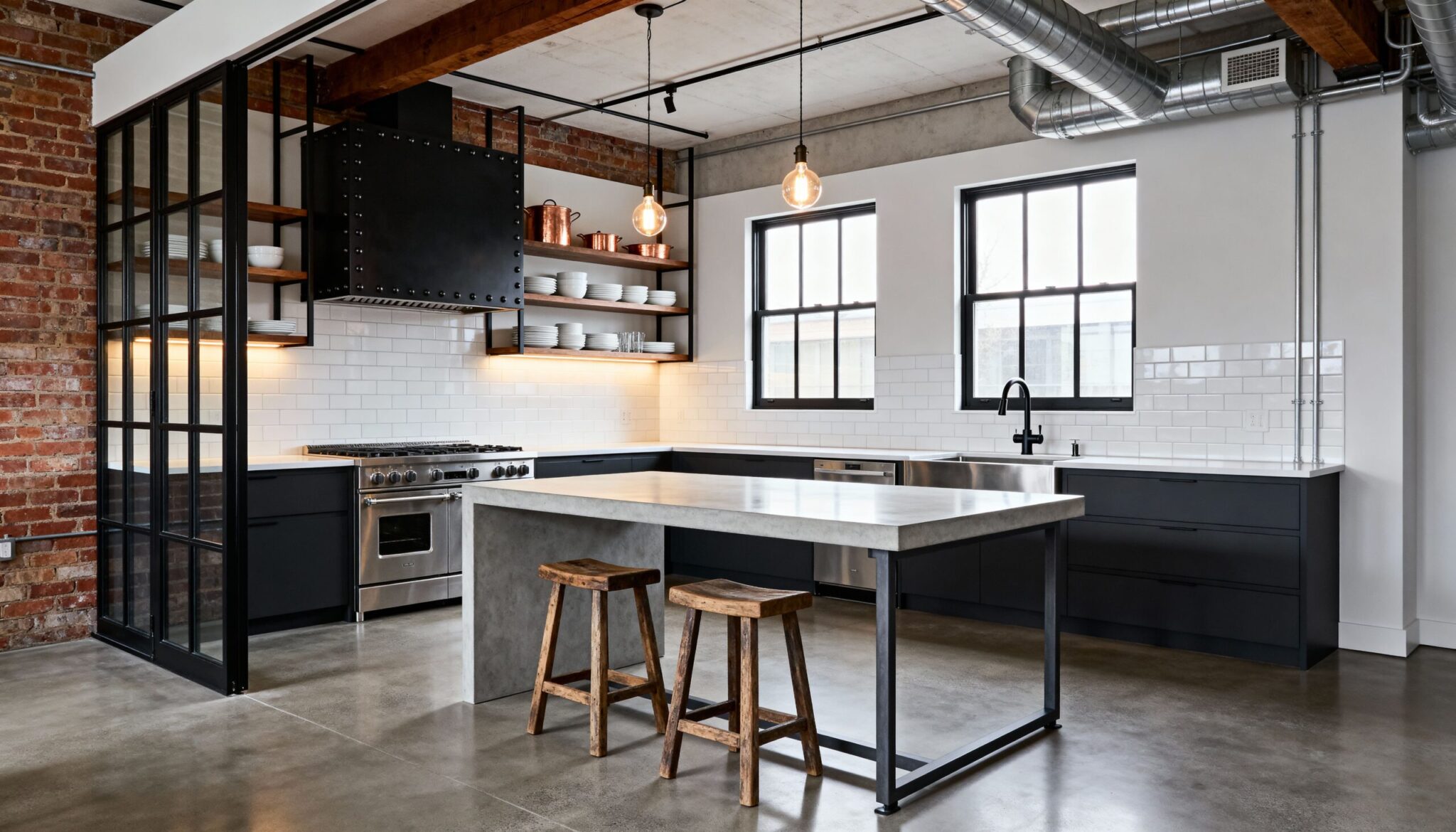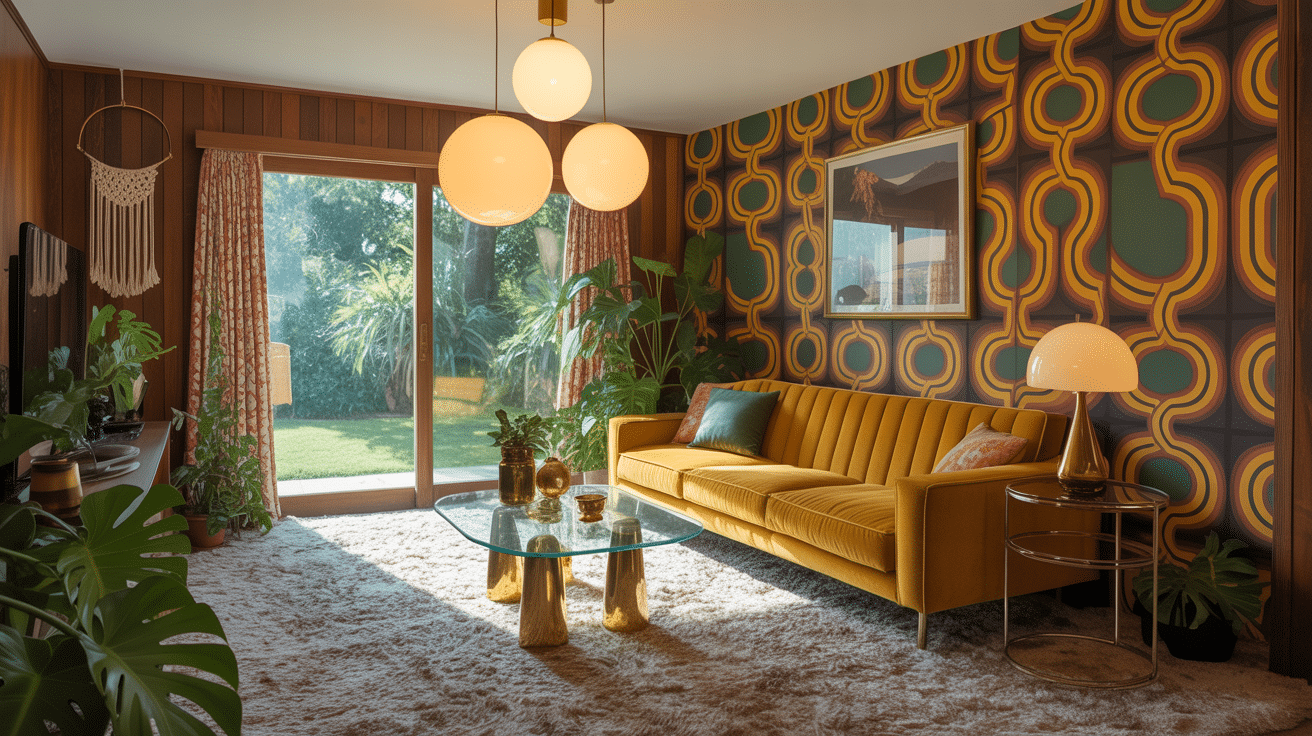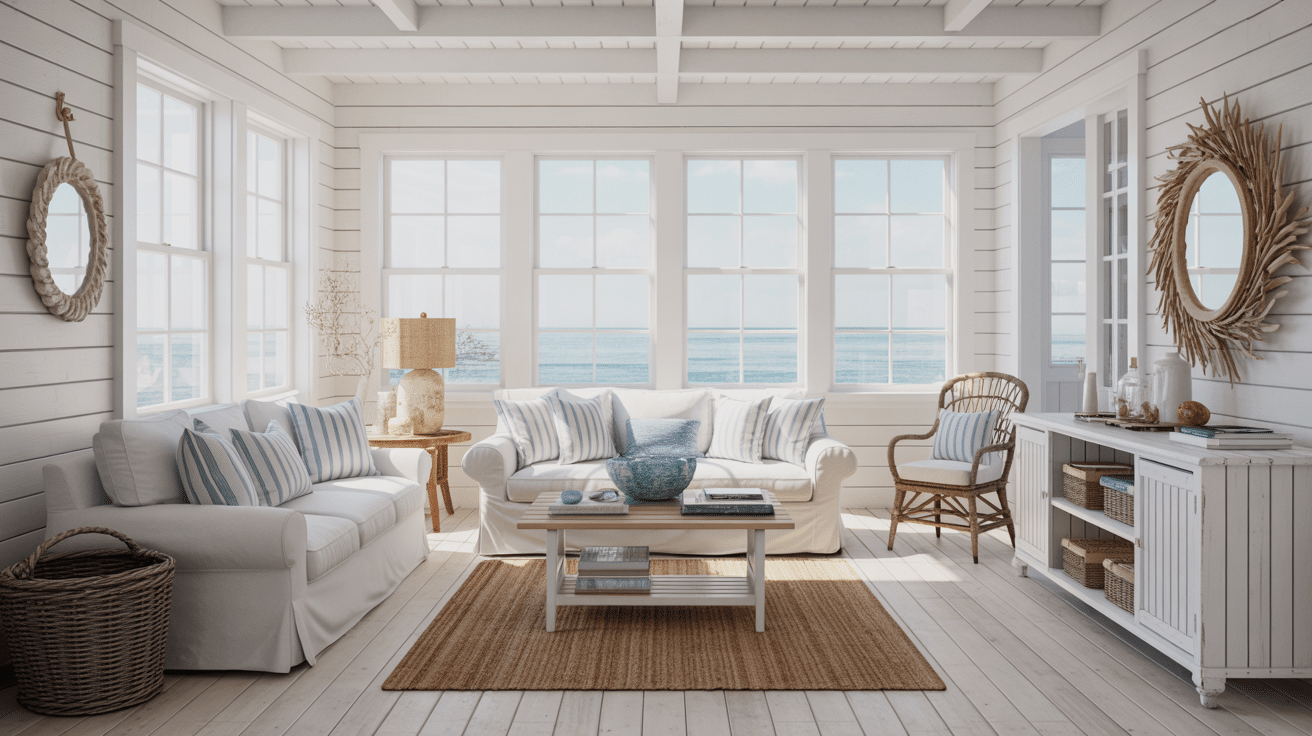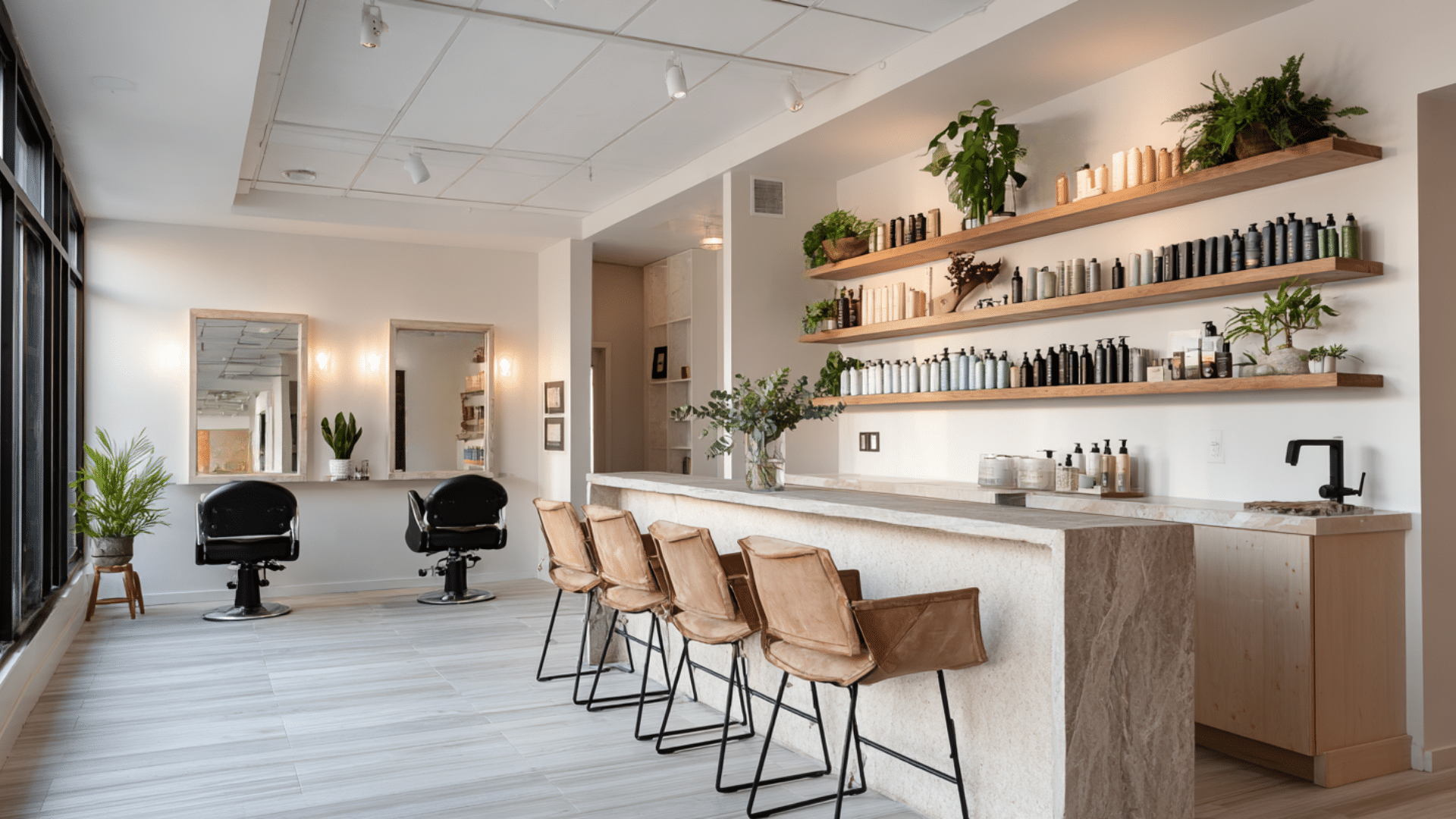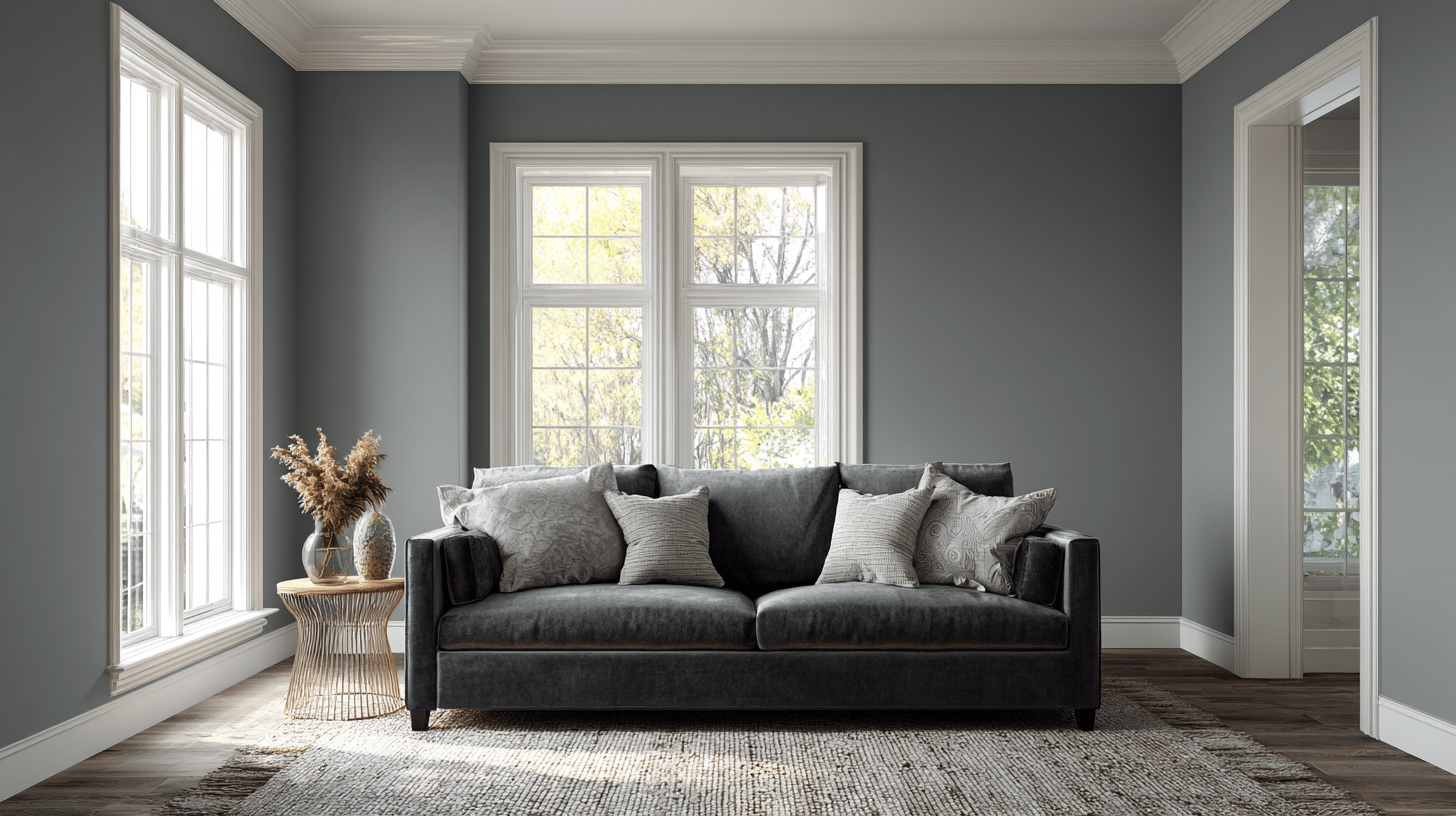Gothic Revival homes stand out on any street with their pointed arches and tall windows.
But most people walk right past them without knowing what they’re seeing. You might have admired their tall windows and pointed roofs, but never understood their story.
This blog covers Gothic Revival origins, architectural features, and famous Gothic Revival house examples.
What is Gothic Revival Architecture?
Gothic Revival architecture is a style that brings medieval church design to residential homes.
Think of those old European cathedrals with their pointed arches and tall spires. Now, picture that same look adapted for houses.
This style became popular in the 1800s when people wanted something different from plain, boxy homes. Builders took inspiration from Gothic cathedrals and monasteries, then made it work for family living.
You’ll see Gothic Revival homes that look like small castles or fairy tale cottages. Some are grand mansions, while others are modest homes.
But they all share that medieval church influence that makes them stand out from other house styles
The Origins & History of Gothic Revival
The Gothic Revival story starts in 18th-century England. People were getting bored with classical architecture and wanted something more dramatic.
They looked back to medieval Gothic cathedrals and castles for inspiration.
Key Timeline:
- 1740s: First Gothic Revival buildings appear in England
- 1830s-1860s: Peak popularity in America
- 1870s-1910s: Second wave with more accurate medieval details
- Post-1920s: Style gradually declines in favor of modern designs
The movement wasn’t just about copying old buildings. It was a romantic rebellion against industrial society.
People missed the craftsmanship and spiritual feeling of medieval times.
In America, Gothic Revival took on its own character. We adapted the style for wooden construction instead of stone. This created the “Carpenter Gothic” substyle with its intricate woodwork and gingerbread trim.
The style represented more than just fashion. It symbolized moral values, craftsmanship, and connection to nature that people felt were disappearing in the modern world.
Key Features of Gothic Revival House
Gothic Revival homes are instantly recognizable once you know what to look for. These features create that fairy tale castle feeling that makes these houses so special.
Let me walk you through the most important exterior and interior elements that define this style.
Exterior Features
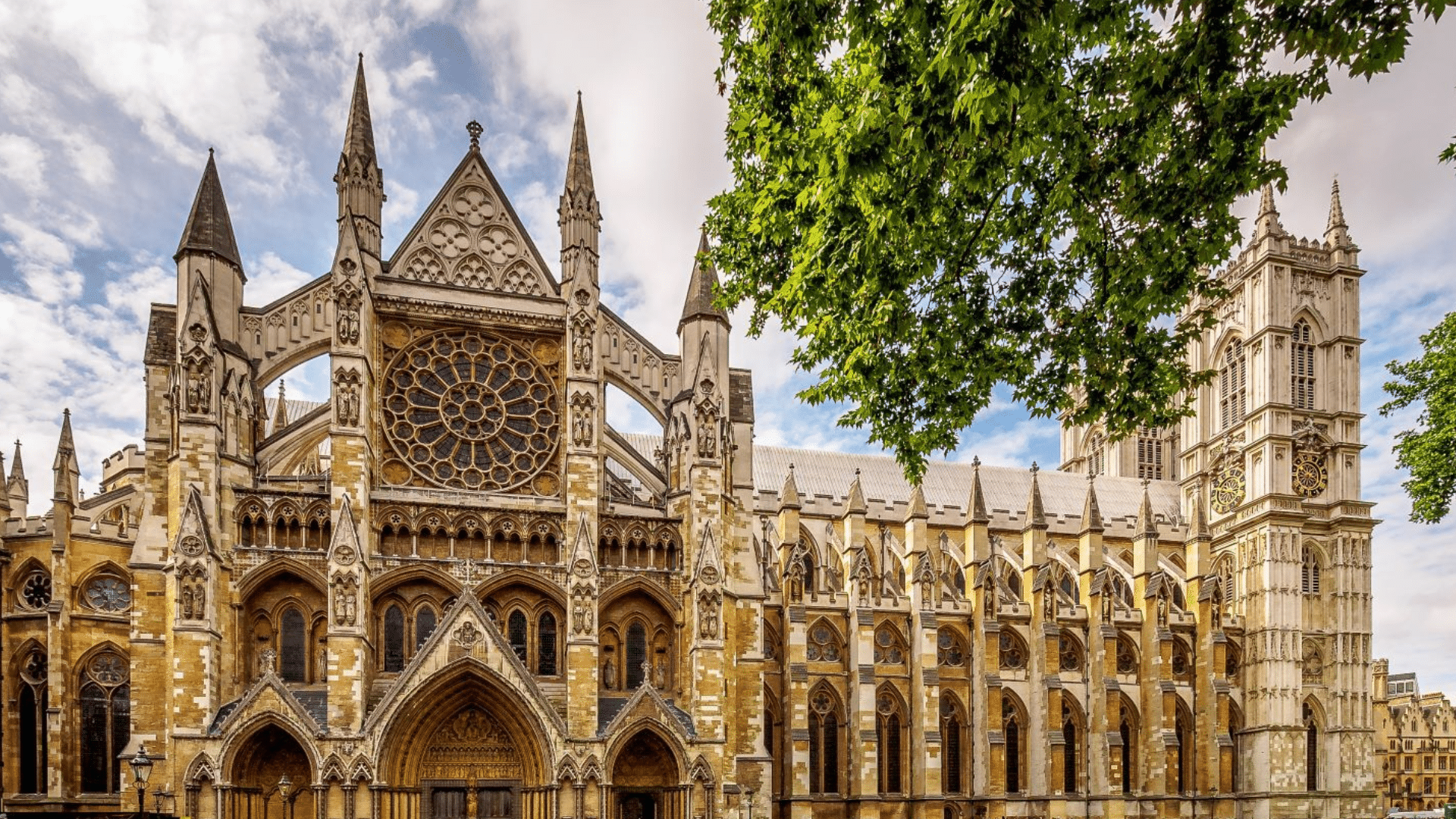
Image Source: @Sotheby’s Realty
The following are exterior features that define the Gothic Revival
1. Pointed Arches
The signature Gothic feature that replaced classical rounded arches. You’ll see them over doors, windows, and decorative elements throughout the house design.
2. Steep Gabled Roofs
Dramatically angled rooflines that create a vertical emphasis. These roofs often feature multiple gables and create the medieval castle silhouette that defines the style.
3. Bay and Oriel Windows
Projecting windows that extend outward from the main wall. Bay windows sit on the ground level, while oriel windows are supported by brackets or corbels.
4. Gothic Tracery
Intricate stone or wood patterns within window frames. These decorative elements mimic the detailed stonework found in medieval cathedrals and add visual interest to facades.
5. Towers and Turrets
Round or polygonal structures that extend above the main roofline. These elements add vertical drama and create the castle-like appearance that Gothic Revival homes are famous for.
6. Decorative Bargeboards
Ornate wooden trim along the edges of gabled roofs. Also called “gingerbread trim,” these intricate details showcase the carpenter’s skill and add Gothic flair to wooden houses.
Interior Features
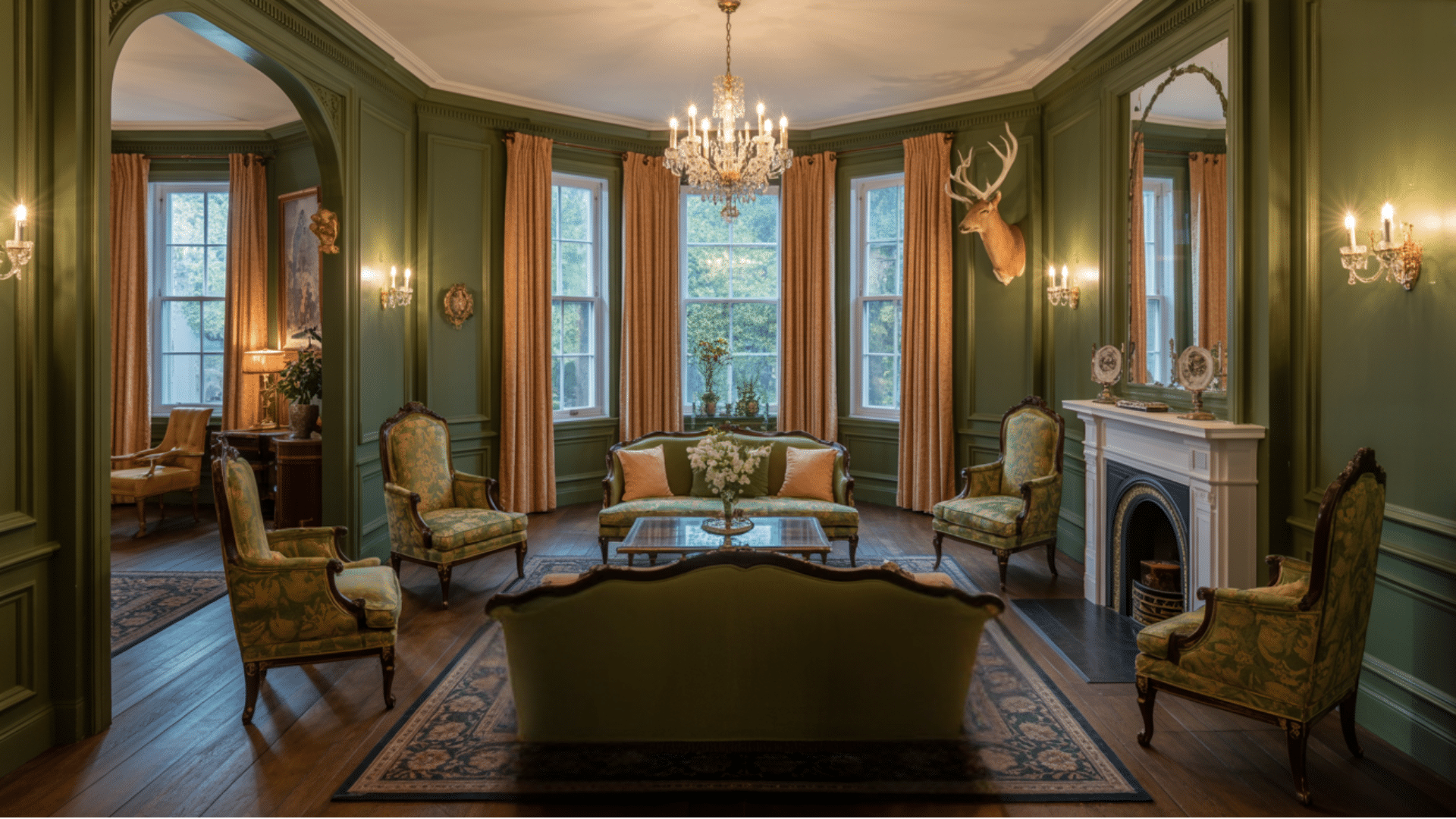
Gothic Revival interiors carry the medieval theme inside with dramatic and spiritual elements.
1. Ribbed Vaulting
Ceiling treatments that mimic medieval cathedral construction. These decorative ribs create visual interest overhead and emphasize the room’s height while maintaining the Gothic architectural theme throughout.
2. Gothic Arched Doorways
Interior doorways featuring pointed arch tops instead of standard rectangular frames. These architectural details carry the exterior Gothic theme inside and create visual continuity throughout the home.
3. Stained Glass Windows
Colorful glass panels that filter light beautifully. Often featuring religious or nature motifs, these windows create a spiritual atmosphere and add dramatic color to interior spaces.
4. Dark Wood Paneling
Rich wooden wall treatments in oak, walnut, or mahogany. This paneling creates a warm, medieval atmosphere while providing an elegant backdrop for Gothic Revival furniture and decorative elements.
5. Stone or Tile Fireplaces
Massive hearths with Gothic arch openings and decorative stonework. These fireplaces serve as focal points and reinforce the medieval castle atmosphere with their substantial presence and architectural details.
6. High Ceilings with Exposed Beams
Soaring ceiling heights that emphasize vertical space. Exposed wooden beams add structural interest while creating the grand, cathedral-like feeling that Gothic Revival interiors are designed to achieve
Famous Gothic Revival Houses Around the World
Some Gothic Revival houses have become legends in their own right. These homes showcase the style at its finest and prove why this architectural movement captured hearts worldwide.
Let me take you on a tour of the most impressive Gothic Revival houses that still stand today.
1. Strawberry Hill House – London, England
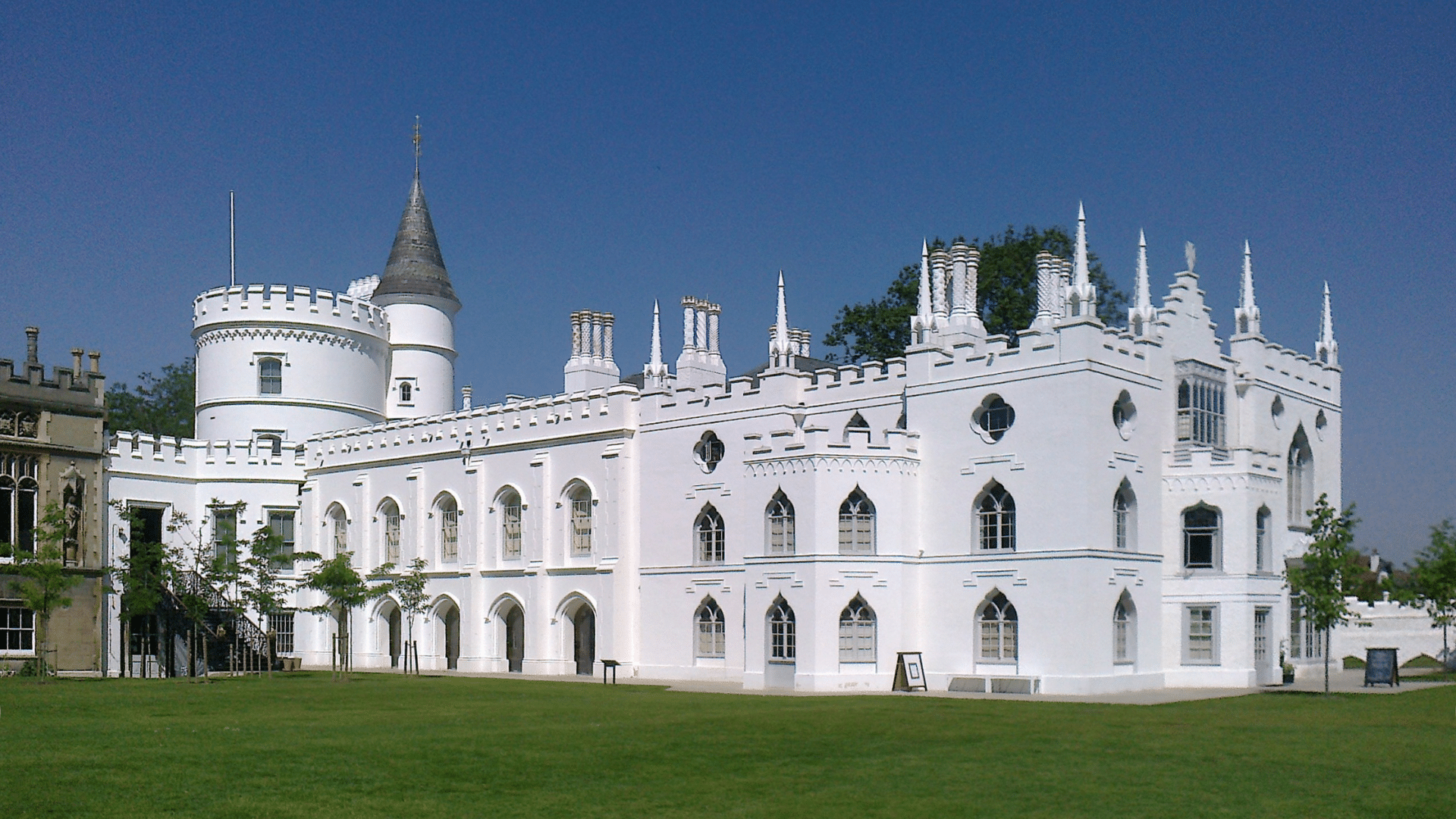
Image Credit: Wikipedia
Built by Horace Walpole in 1749, this villa started the entire Gothic Revival movement. Its whimsical towers, pointed windows, and medieval-inspired interiors shocked Georgian London.
Today, it’s considered the birthplace of Gothic Revival architecture and remains open for public tours showcasing its historic significance.
2. Lyndhurst Mansion – Tarrytown, New York
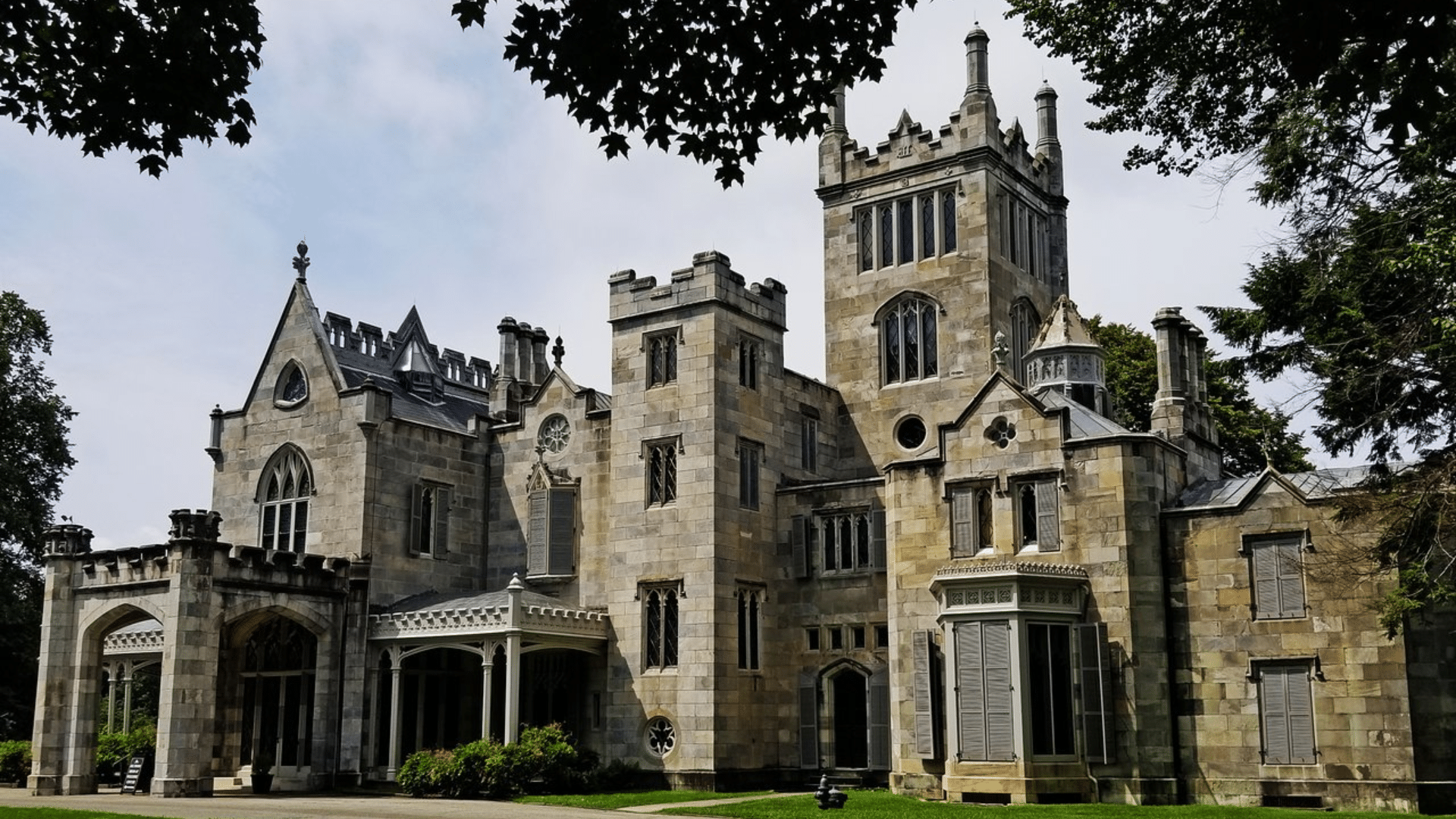
Image Credit: TripAdvisor
Designed by Alexander Jackson Davis in 1838, this Hudson Valley masterpiece features asymmetrical towers, pointed arch windows, and elaborate stonework.
The mansion served as a country estate for wealthy New York families.
It now operates as a historic house museum with original furnishings and decorative arts.
3. Balmoral Castle – Aberdeenshire, Scotland
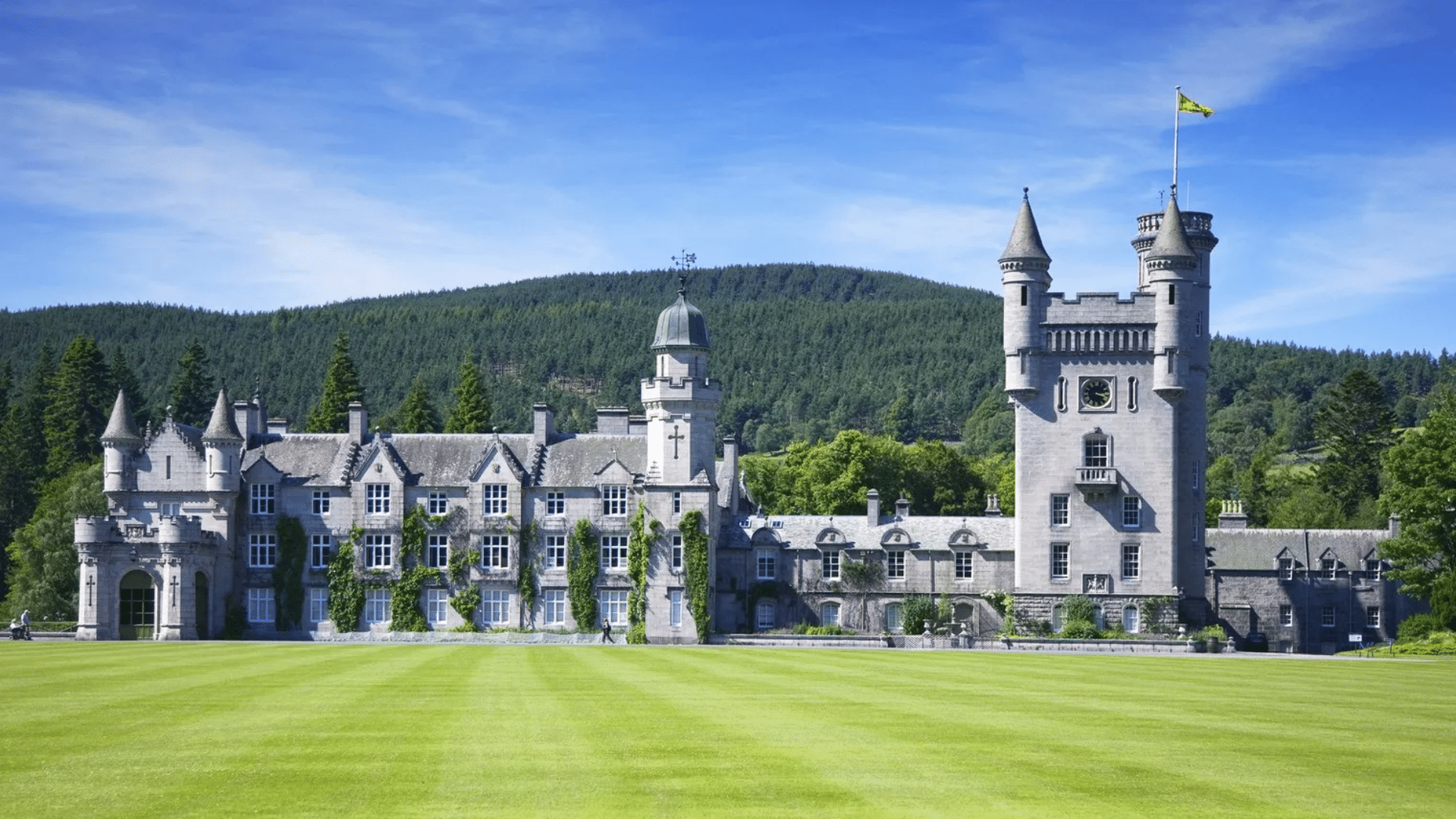
Image Credit: House&Garden
Queen Victoria and Prince Albert rebuilt this royal residence in Gothic Revival style during the 1850s.
The castle features pointed towers, bay windows, and Scottish baronial elements that blend Gothic Revival with local traditions.
It remains the British Royal Family’s private residence and showcases how the Gothic Revival influenced even royal architecture.
4. Roseland Cottage – Woodstock, Connecticut
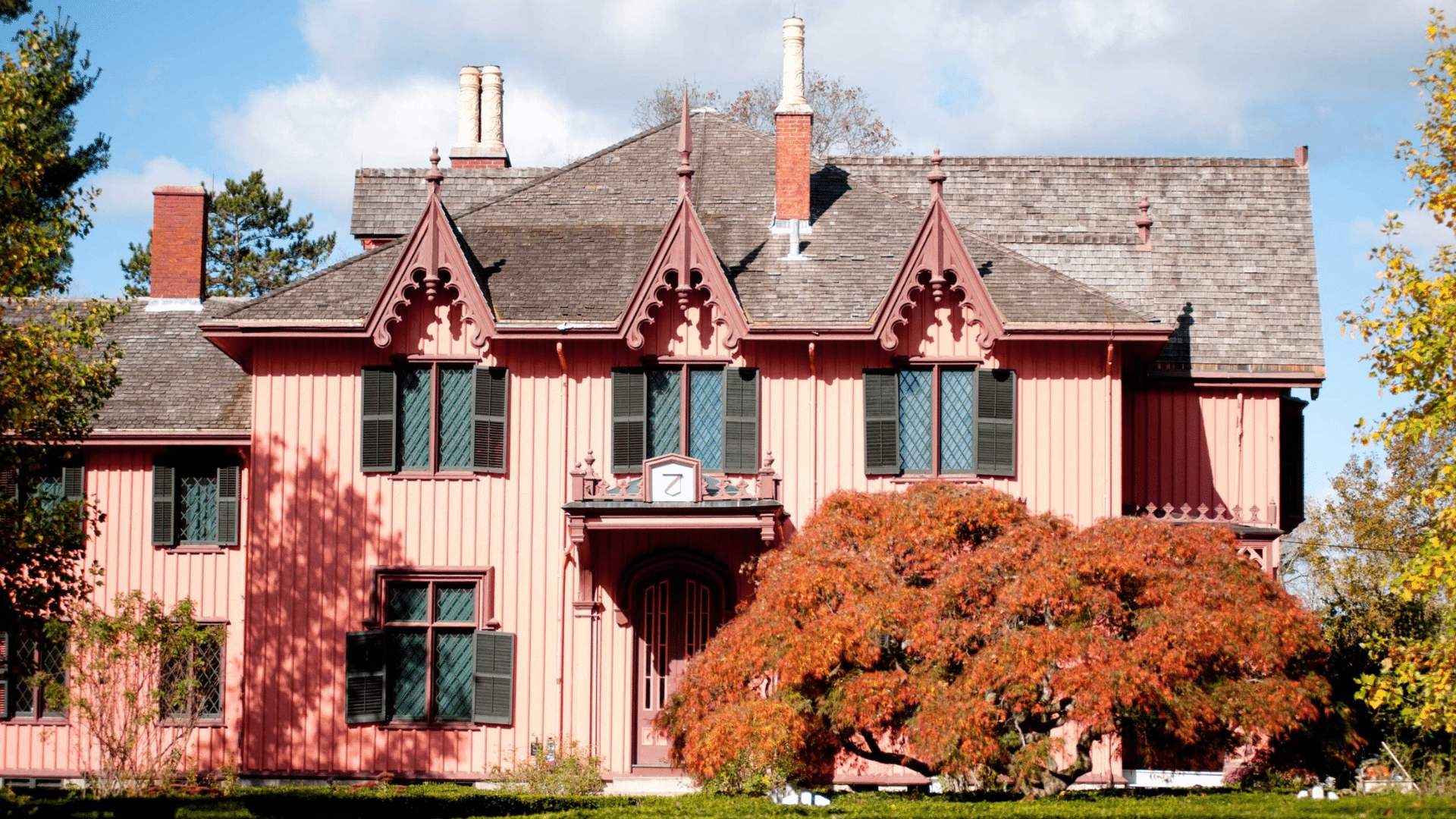
Image Credit: Connecticut History
This charming pink Gothic Revival cottage was built in 1846 as a summer home for wealthy New Yorkers.
Its vertical board-and-batten siding, decorative bargeboards, and pointed arch windows create a fairy-tale appearance.
The property includes original Gothic Revival outbuildings and maintains period-appropriate gardens and interiors.
5. Wedding Cake House – Kennebunk, Maine
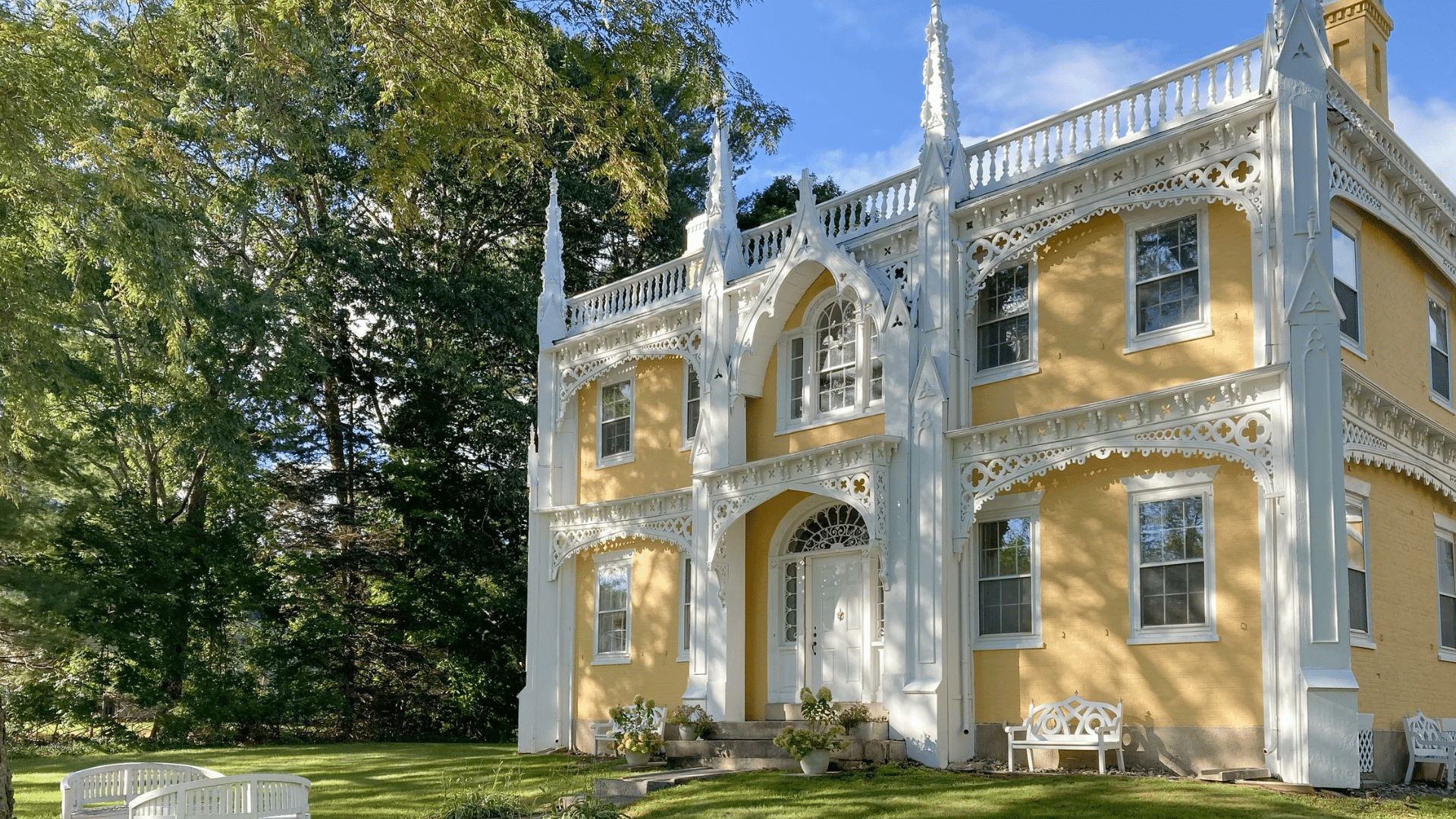
Image Credit: The Wedding Cake House
Built in 1826, this wooden Gothic Revival house earned its nickname from the intricate white gingerbread trim covering every surface.
Local shipbuilders created the elaborate scrollwork using marine carpentry skills.
The house demonstrates how American craftsmen adapted Gothic Revival details for wood construction rather than traditional stone.
6. Oaklands Mansion – Murfreesboro, Tennessee

Image Credit: Wikipedia
This 1815 plantation house received Gothic Revival updates in the 1850s, including pointed arch windows and decorative trim. During the Civil War, it served as headquarters for both Confederate and Union forces.
Today, it operates as a historic house museum showcasing antebellum life and Gothic Revival architectural details.
7. Victoria Mansion – Portland, Maine
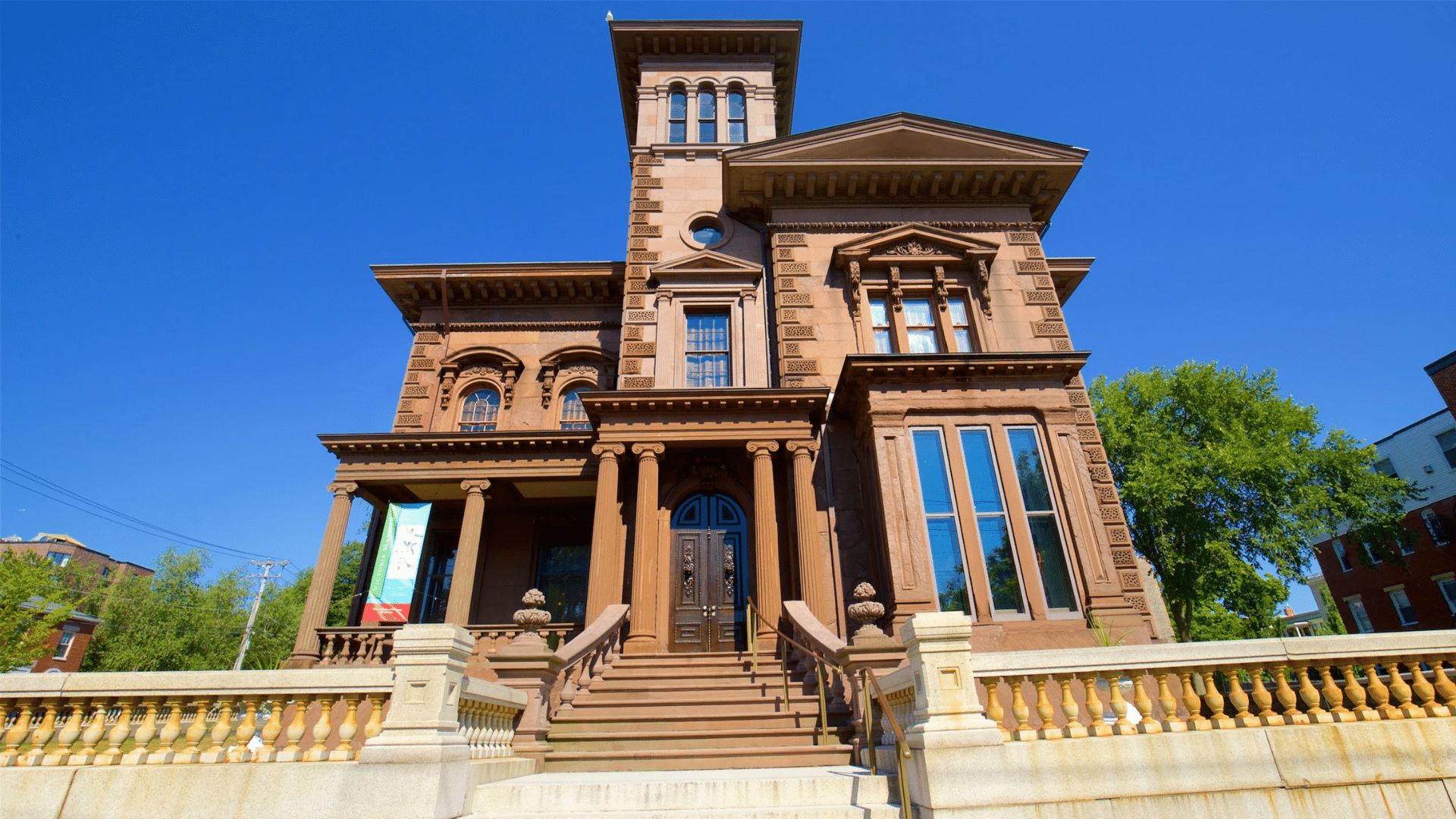
Image Credit: Expedia
Completed in 1860, this Italian Villa-style house incorporates Gothic Revival elements like pointed arch windows and elaborate interior woodwork.
The mansion features original Herter Brothers furniture and decorative arts.
Its preserved interiors offer visitors a glimpse into wealthy 19th-century American life with Gothic Revival influences throughout.
8. Olana – Hudson, New York
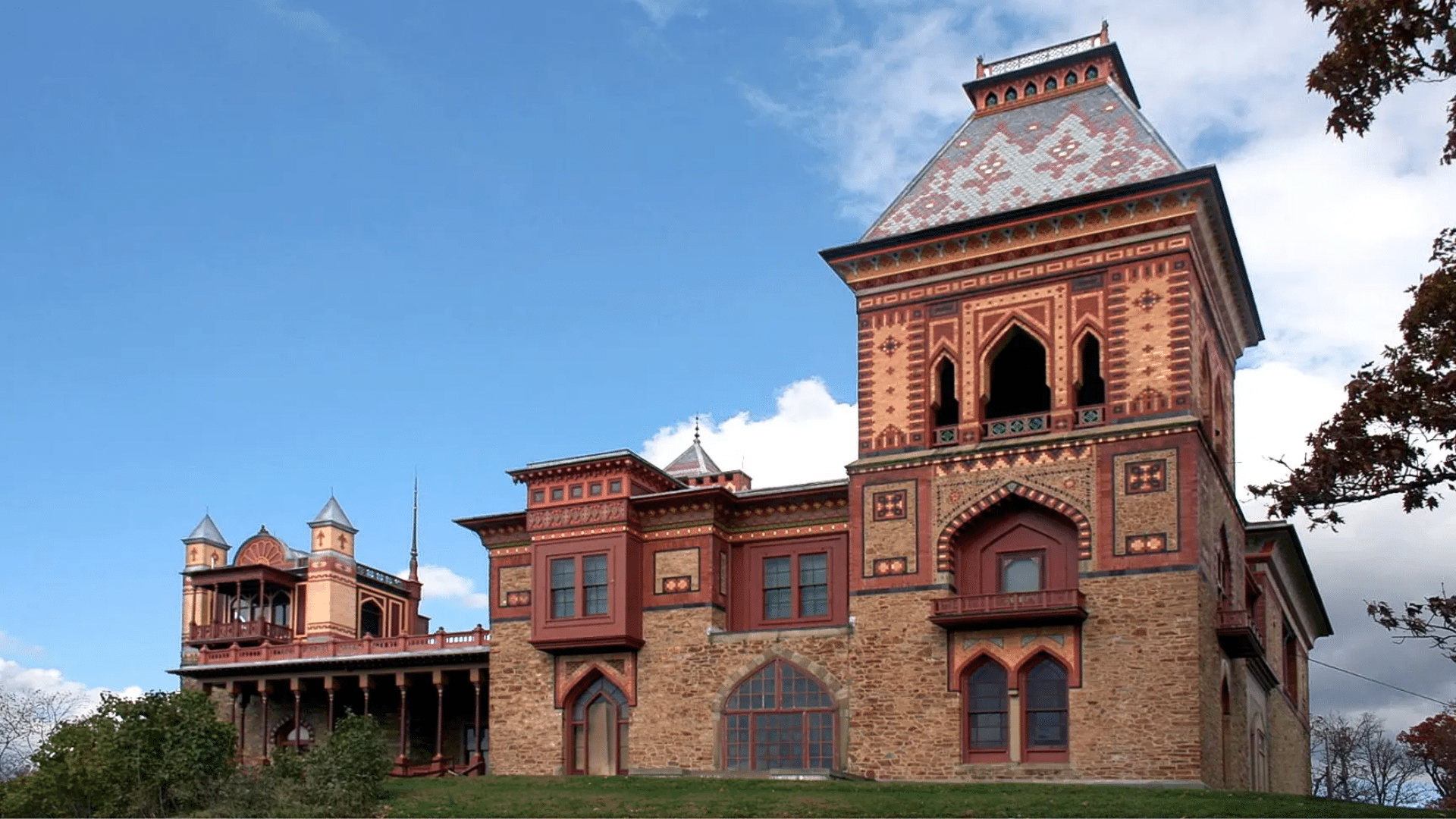
Image Credit: Patch
Artist Frederic Edwin Church designed this Persian-influenced house with Gothic Revival elements in 1870.
The mansion features pointed arch windows, decorative stonework, and elaborate interior details.
Church’s artistic vision created a unique blend of architectural styles that reflects his travels and artistic sensibilities throughout the Middle East.
9. Kingscote – Newport, Rhode Island
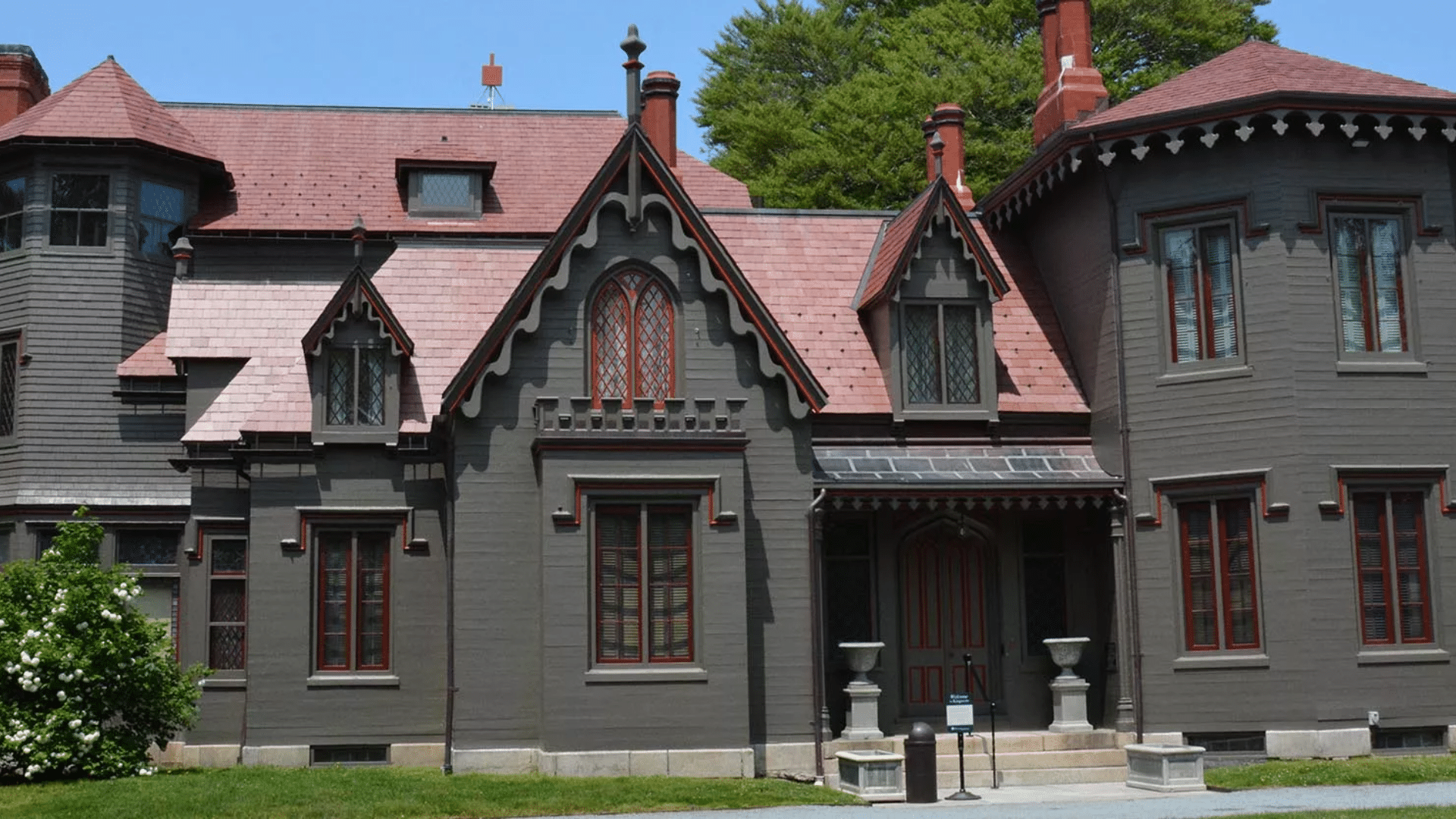
Image Credit: TripAdvisor
Built in 1839 by Richard Upjohn, this Gothic Revival cottage was one of Newport’s first summer “cottages.”
Its board-and-batten siding, pointed arch windows, and asymmetrical design influenced countless other Gothic Revival homes.
The house features original furnishings and demonstrates the style’s adaptation for seaside living.
10. Litchfield Villa – Brooklyn, New York
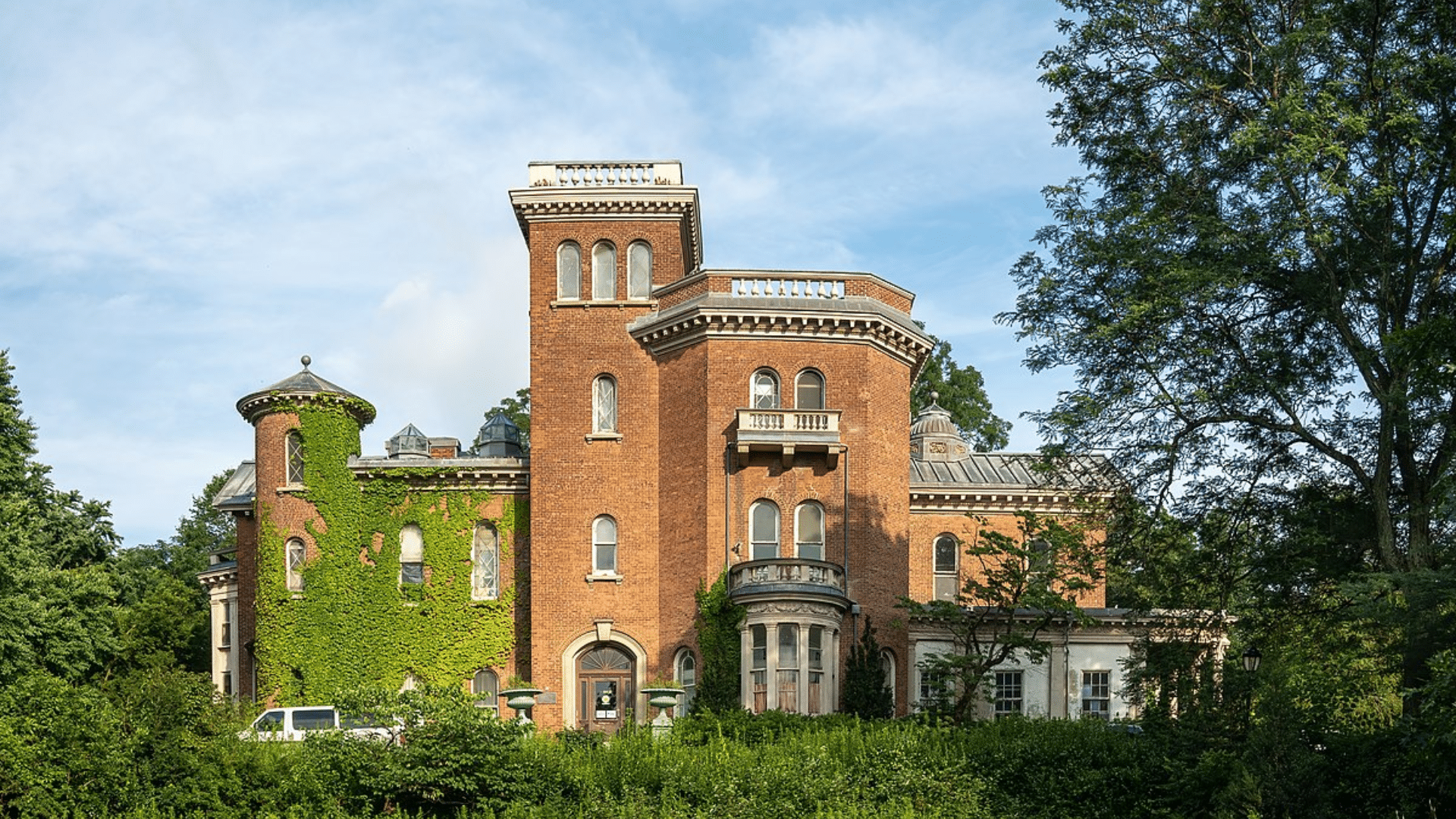
Image Credit: Wikipedia
This 1847 Gothic Revival mansion features elaborate stonework, pointed arch windows, and a distinctive asymmetrical tower.
Originally built for a wealthy merchant family, the house showcases high-quality craftsmanship in its carved details and interior woodwork.
It represents the style’s popularity among New York’s emerging middle class during the mid-19th century.
11. Sunnyside – Tarrytown, New York
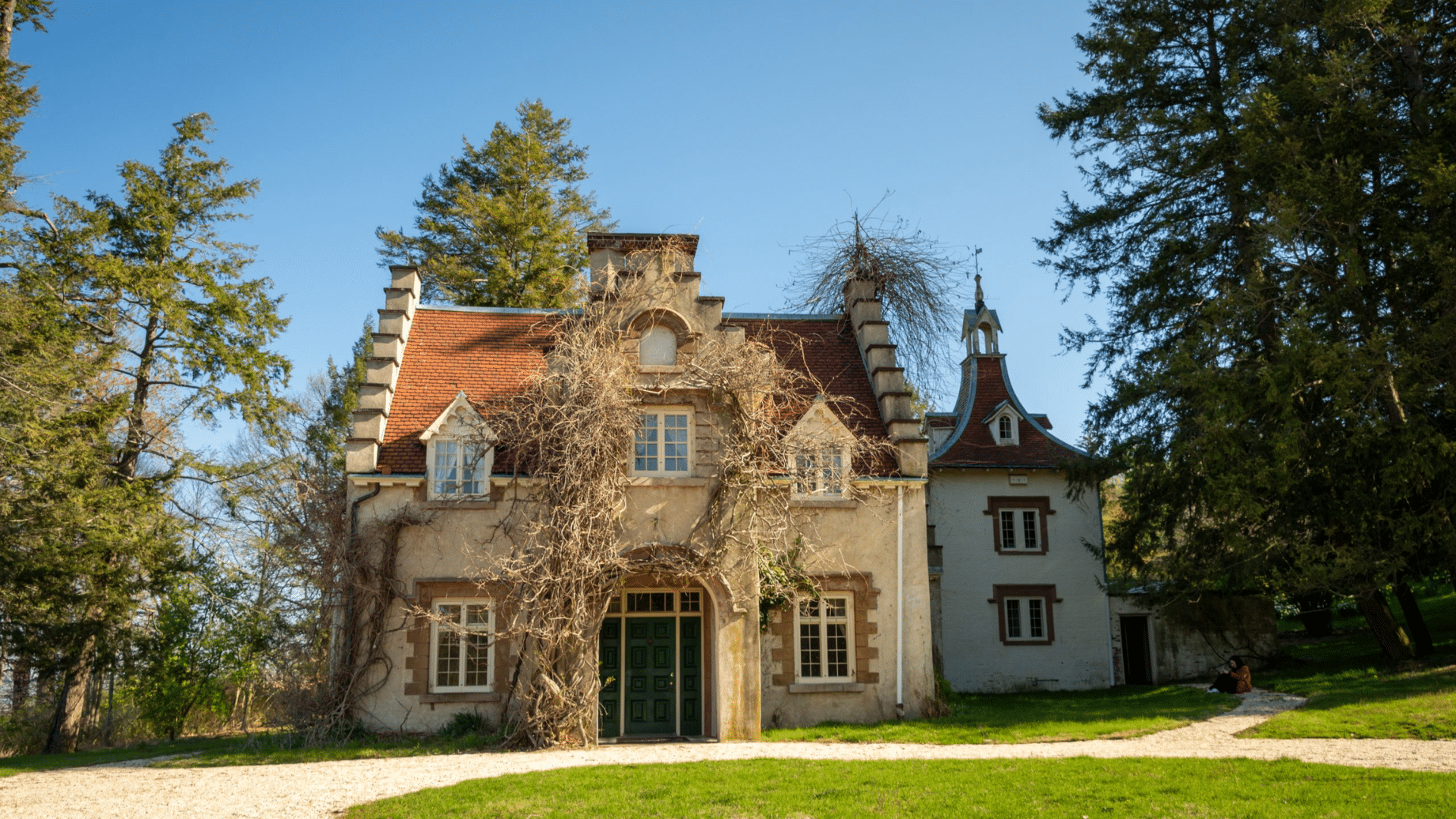
Image Credit: Sleepy Hollow
Author Washington Irving transformed his modest Dutch cottage into a Gothic Revival showpiece in 1835.
The house features weather vanes, pointed dormers, and romantic ivy-covered walls that inspired countless American writers and architects.
Irving’s home became a pilgrimage site for Gothic Revival enthusiasts and literary fans alike.
How to Get that Gothic Touch in Your House
With some thoughtful choices and creative touches, you can capture this style’s romantic spirit and make your own gothic homes.
- Add pointed arch details to doorways and windows: Use wood trim or molding to create that signature Gothic shape over existing openings.
- Install tall, narrow mirrors with Gothic frames: These instantly add height and drama while reflecting light throughout your rooms.
- Choose deep, rich colors for walls and fabrics: Think burgundy, forest green, and midnight blue to create that medieval atmosphere.
- Incorporate wrought iron elements in lighting and hardware: Chandeliers, door handles, and curtain rods with Gothic patterns make a big impact.
- Display stained glass panels in windows or as wall art: Even small pieces can transform ordinary light into colorful, cathedral-like effects.
- Use heavy, textured fabrics like velvet and tapestry: These materials on curtains, pillows, and upholstery bring authentic Gothic weight and richness.
- Add carved wooden furniture with Gothic motifs: Look for pieces with pointed arches, trefoil patterns, or medieval-inspired details
To Wrap Up
Gothic Revival houses prove that good design never truly goes out of style.
These homes have been turning heads for nearly 300 years, and they’re still doing it today.
What started as a romantic rebellion against boring architecture became something much bigger. It gave us homes with personality, character, and soul. Every pointed arch tells a story.

